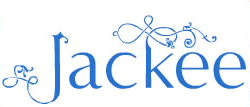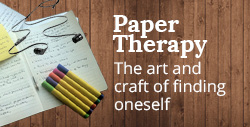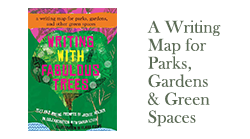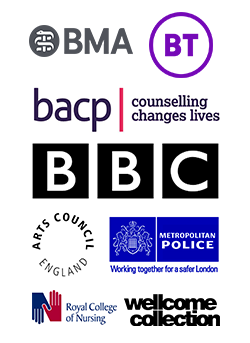Writing
Monday, February 4th, 2013
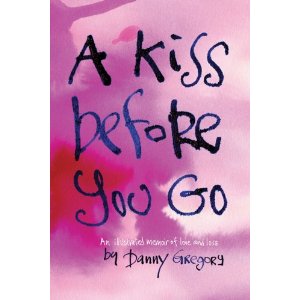
I’ve always received great value from Danny Gregory’s books on creativity, drawing and writing. His books are a sensual, kaleidoscope of colour, sketches and insights into writing and creativity. I was always particularly taken in by the handwriting script, which are the fonts all of his books are published in. Being a handwriting fanatic this alone is enough to have me hooked.
One of his titles, The Creative License is never far from reach. Since reading it over six years ago I’ve re-read it at least three times from cover to cover and have dipped in and out of it on numerous occasions, extracting quotes, refreshing my memory on the great content he shares about creativity and gathering ideas for writing activities. His book has helped me get unblocked several times over. Only last week on a one-day writing retreat I was teaching I used Danny’s lessons about drawing as a retreat exercise to really see and draw an object on the room we were working in.
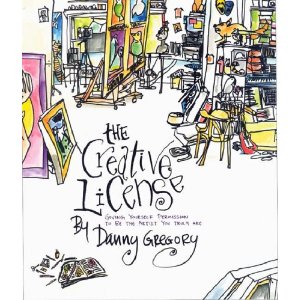
When I first read the book just a few pages in Gregory managed to convince me that I could draw (I hadn’t really drawn since secondary school) and I was happily sketching away in my notebook in no time at all.
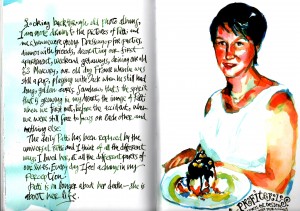
So imagine my delight last week whilst online by sheer chance I discovered that Gregory had published a new book. I’m the sort of person who writes down the date six months in advance when a writer whose work I love latest book will be published.
The days leading up to it’s arrival feels like hot flushes and flutters of excitement and anticipation that surround a first date.
I pressed click on the Wednesday and it arrived on the Thursday thanks to the super powers and might of Amazon.
A Kiss Before You Go is part memoir, part non-fiction, and part lessons on creativity, hope and loss. Gregory tells the heartbreaking story about the death of his former wife Patti. Reading it I am reminded that whenever someone recounts a tragedy that hope is never faraway. Hope waits in the shadows, waiting for the opportunity to take up residence just when one believes it doesn’t exist. This book and its contents are a timely reminder of this.
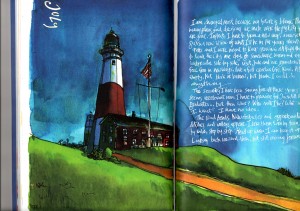
Since the cause of death was not mentioned at the time of Patti’s death, Gregory writes as someone who has found peace with this great loss. You feel the emotions raw but not ragged. Worked through enough that you the reader are not sucked in by them. Meaning has been made making it a story that is tellable.
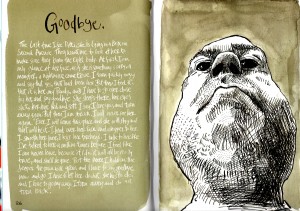
Danny’s words are healing, open, wise and vulnerable what some would describe as medicine words.
Writers and artists like Danny Gregory move and inspire me.
They move me to create when I don’t feel like it. They motivate and galvanize me to keep on writing and through writing righting my own life by examining the interior self.
Artists like Gregory remind me of why I am motivated to support others to feed and nourish their own creative hungers. He’s one of my writing mentors and his books would definitely accompany me on a trip to a desert island.
Oh…… and I’ve just this minute discovered these photographs on the inside cover of the book cover jacket. I’d taken the cover off so I could read the book in the bath. This book is full of surprises. To find out more about Danny Gregory and order his books click here
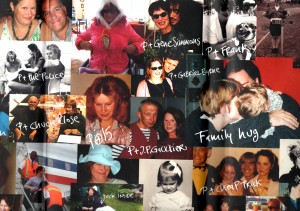
No Comments
Friday, February 1st, 2013
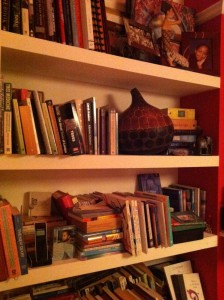
I’m a self confessed bookaholic. Okay there it is. It’s out in the open. I love books, sleep with books on my bed, fall asleep with a book in my hand and reach for a book first thing when I wake up. I even have the luxury of a room dedicated to hundreds of my books. Sometimes I’ve been prone to buy a book mainly because I love the cover.
So last night I responded to an intuitive nudge to share three of my favourite book covers from my personal book collection. So. here goes:
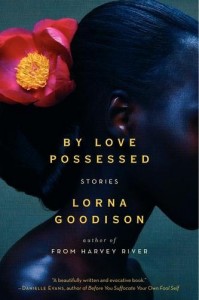
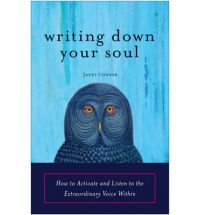
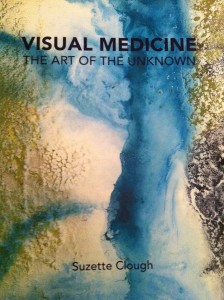
- Which of the covers are you most inspired by?
- Let us know what your absolute favourite book cover is. We’d love to share the book covers that inspire you.
I’ll add a few more over the weekend.
No Comments
Monday, January 28th, 2013
 On Saturday we held the first of the Writing With The Senses one-day retreats for writers. A lovely group of writers gathered in the calming space inside the Yurt on the grounds of Quiet View in Canterbury. Over the course of the day the writers plunged into a series of Writing With The Senses practices designed to crack open their writing.
On Saturday we held the first of the Writing With The Senses one-day retreats for writers. A lovely group of writers gathered in the calming space inside the Yurt on the grounds of Quiet View in Canterbury. Over the course of the day the writers plunged into a series of Writing With The Senses practices designed to crack open their writing.
Using the Writing With The Senses e-book as our guide the group of writers faced their fears, doubts and anxieties about writing as they received a mixture of coaching, writing insights and tips.
One thing all the writers present had in common was the presence of the inner critic. Smart and often cunning the inner critic takes shape in many disguises or characters, showing up in a myriad of ways writers hold themselves back. From feeling that their story was not worthwhile, that they had to write perfect pieces first time (a complete myth), from who do I think I am to want to write a deck of Oracle cards.
We laughed together as I suggested that each writer’s inner critic was simply in the wrong job. The inner critic’s original job the one, which they are well qualified for is at the stage of the writing process which requires editing, re-writing or polishing stages. But so many writers having experienced criticism way before they were ready for it at too early an age and often at the fragile and vulnerable points of experimentation meant many ended up with wounds carried over into adulthood.
This idea of the inner critic being wrongly assigned job duties resonated with the group and we laughed even more when I suggested that each writer could personally assign the inner critic a new post one where they would be fully occupied until their rightful services were called for.
I shared an example of my own re-assignment of my inner critic. I explained how she had recently been head hunted for a new post as Global Head of all out of order traffic lights around the world. Of course she was made an offer she couldn’t refuse and we parted company amicably. Last I heard she was rushed off her feet with all the demands from her new role that she apologized for having little time to check back in on me.
But I’m not complaining. Her absence has created a noticeable and remarkable shift since her new posting. I’m far less cautious. I put things out there even when I think they’re far from perfect and I’m loving the new waves of creativity and inspiration that’s sweeping across the entire body of my work.
So where will you re-assign your inner critic to? Don’t hesitate. Explain that his or her services are no longer needed right now but he or she will be called upon for short contracts that have clear time lines, boundaries and contracting that clearly define the role and requirements during the editing and revising stages of your work. Explain that her role and responsibilities will be fully explained and that she will be released from duties as soon as her job is complete.
The size of the group meant that writers received individual coaching and feedback and no one was overlooked. Each writer left with valuable feedback on their writing from their peers along with a plan of their next writing steps.
Feedback from Saturday’s workshops included:
- Small is beautiful
- I valued the sensitive, creative and insightful exercises, which were affirming
- Skilful leadership
- I felt I achieved the freedom and permission to feel comfortable to put pen to paper
- Felt very indulged by having a small and intimate group
- Very well presented
- A wonderfully easy day to be part of and a privilege
Our next workshop at Quiet View is on Saturday May 18th. This time of the year spring is fully awake from her winter slumber and is an ideal time to really be with the land and nature at Quiet View. It’s your opportunity to treat your writing self to a day of nourishment, indulging in the senses as a way of deepening your writing and cultivating your writing voice.
Our package includes a follow up coaching session and is a great special offer of £97.00 for the May 2013 workshop which includes a 30-minute follow up coaching call. Bring a friend and you both get the workshop and coaching for £150.00. Click here for more details
Once you’ve attended one of our Writing With The Senses workshops you’re free to attend one of our 2013 dates for free as our guest. Recommend a friend to Writing With The Senses and you’ll win a complementary 30-minute coaching call with me as a thank you gift.
No Comments
Saturday, January 19th, 2013
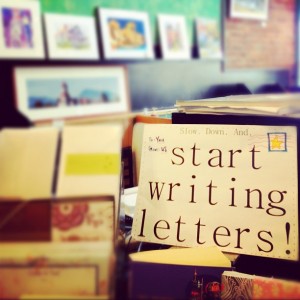 Photo Credit Tammy Strobel
Photo Credit Tammy Strobel
There’s something deeply ritualistic and at the same time comforting about writing a letter. Over christmas despite the ridiculous price of first class postage stamps I sat down one morning and hand wrote personalised messages in over sixty christmas cards.
Very quickly I found myself transported through time as memories of each person flickered across my mind during the minutes spent writing their names and a short message. The feelings and emotions that engulfed me felt warm, cozy and comforting. Suddenly I felt connected to each person. A permanent smile set up home on my face during the full duration for the time that I sat writing.
Perhaps I’d experienced a rise in endorphins the feel good emotions stimulated by the very act of sealing each envelope as if a part of me was being preciously wrapped inside, waiting to pop out once the envelope was opened. I experienced another surge of energy accompanied by a huge sense of accomplishment when I posted my wad of letters in the red pillar-box outside the local post office. Even planting the stamp ritualistically on the right hand corner of each envelope felt grounding, affirming and a sense of completion.
Somehow no matter how personal the contents of an email writing it and sending it virally personally doesn’t stimulate the same kinesesthic and visceral feelings generated from the act of sitting down and writing a letter or card by hand. This year I’m on a campaign to reinvigorate the art of letter writing.
Shortly after that experience of my Christmas card writing expedition I attended a Christmas artist market close by to where I lived. It was housed over three floors of a pub and was full of independent artists and crafts people selling their Christmas wares.
Arriving on the top floor my eyes were immediately drawn over to a group of people who appeared to be writing. Always inquisitive and just that little bit nosey I moved in closer to inspect what was going on. Much to my delight I discovered Claire the founder of this writing café Letter Lounge sitting at a table fully stocked with writing paper, pen, envelope and most important stamps. All I had to do was sit down at the table and write someone a letter.
I didn’t need any persuasion. I‘d already pulled up a chair unlike my sister who touched the paper and pens quizzically whilst saying out loud, “I don’t get this.” I could see how logic was not giving her a quick hit on what she would get from engaging in a letter writing experience.
Letter writing is a slow fix that crawls through the body as the letter unfolds. She would only discover the joys of letter writing from the act of writing the letter itself. So many of our activities in these modern times are dependent on us being externally gratified even though short lived without having to personally expend much energy.
It’s the engagement of the body that I find fascinating in the process of letter writing. The heart connected to the arm, connected to the pen, connected to the nib, which connects to the pen that channels all of this into the words and sentences on the surface of the page intrigues me in a way that writing on a keyboard doesn’t. Letter writing involves a suspension of time and space and time travelling and an emergence into Freud’s the psychoanalyst’s concept of Free Association.
My sister soon settled down and for the next twenty minutes we were both immersed on the blank page as we wrote letters to my daughter who had recently moved to live in Dubai.
As I wrote I found myself starring off into space and then coming back to the page. Each line I wrote felt deliberate and handpicked. It was slow which felt good and time somehow stretched supporting my time travel between the past and the present as I retrieved memories that I wanted to capture on the page.
“ Such a sweet gift – a piece of handmade writing in an envelope that is not a bill, sitting in our friends path when she trudges home from a long day spent among wahoos and savages, a day our words will help repair.’ writes Garrison Kellor in her chapter for the book, We Are Still Married – How To Write A Letter (Keillor, 1989)
By the time my sister had finished writing her letter she too had a huge smile on her face. “I really enjoyed that, it made me think in a way I am not accustomed to. I’m going to get the children at school to write letters. I think they will end up feeling as good as I did.” She had caught the fever, the deep satisfaction had swept over her whole body and her face was awash with emotions.
My daughter was delighted when she received the letters out of the blue some weeks later. Claire had provided us with stamps on the spot so both letters could be on their way to Dubai where my daughter is temporarily living.
The letters were not only a big surprise but they brought a new type of conversation into her space. We had not seen her for three months but now with our letters in her possession the lack of our physical presence was replaced by the fact the she could now touch, hold and sense our words. Our letters made us feel that much closer to her and every time she thinks of them it brings a huge smile to her face.
- When was the last time you wrote someone a personal letter?
- When was the last time you received a personalized, hand written letter or card through the post?
Is the handwritten letter is in danger of becoming extinct? You could change that this weekend by finding yourself some paper or a card, a pen, envelope and stamps. Give yourself 30 minutes and sit and write anything that comes to mind to your chosen person to write to. If you make a mistake simply put a straight line through it and continue.
So who will you write your first letter to and post in a letterbox?
Check out Claire’s website www.letterlounge.co.uk and the www.thejoyofslowcommunication.com
Read part two of this blog next week for tips from a great article by Garrison Keillor on How To Write A Letter.
No Comments
Tuesday, January 15th, 2013
 As long as I can remember I’ve always had a drawer full of buttons somewhere. Right now down the hallway in a room where I keep my clothes and shoes if you open the top left hand drawer of an old pine chest of drawers you’ll find an elaborately decorated case full of buttons.
As long as I can remember I’ve always had a drawer full of buttons somewhere. Right now down the hallway in a room where I keep my clothes and shoes if you open the top left hand drawer of an old pine chest of drawers you’ll find an elaborately decorated case full of buttons.
It’s stuffed full of the odd button here and there that are remnants of garments I‘ve either loved, lost or grown out (much to my dismay) of over the years.
I always hold onto buttons in hope. In hope that one day I will find the zeal, even the finesse to sit down like my mother did and sew things back together.
Unfortunately I have never been able to ennoble those characteristics inside myself so the collection has simply grown over the years with little purpose and with no role other than to sit in the drawer, tightly locked away in its elephant decorated case.
That’s why I was delighted when I came across away of using buttons as writing prompts. I discovered the exercise in Gillie Bolton’s book, Write Yourself: Creative Writing and Personal Development.
Here’s an excerpt from a member of a therapeutic writing group introducing ways of using buttons as writing prompts in a writing group setting. This can of course be adapted for when writing on your own.
“ The buttons scattered buttons the table between us. Willing hands fanned, preventing them rolling away. Six poets used to critiquing our poems, we were now exploring first draft writing. The large button collection, many antique were from my grandmothers and other sources.
Previous to pouring this multicoloured cascade, we had all written for six minutes with no subject, and no thought of reading out. Each had scribbled furiously whatever was there, with no attention to grammar, punctuation or even sense: writing for the sake of writing, to spill the contents of the mind onto the page.
After examining the buttons, we then choose some for ourselves and each other with no explanation and little talk. There was a childish pleasure of giving and receiving gifts.
Tearing ourselves away from the gleaming colourful heal, we each write about our own pile, initially anything about the button experience, for about ten minutes. Then I suggested that some of the buttons might represent someone or something in each of our lives past or present. We had 20 to 30 minutes for this.”
Bolton, G. (2011) Write Yourself: Creative Writing and personal Development. London. Jessica Kingsley Publishers

No Comments
Friday, January 11th, 2013
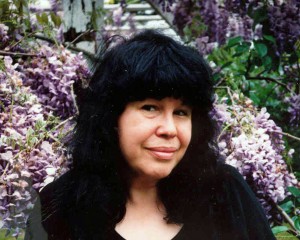 Unlearning to Not Speak
Unlearning to Not Speak
By Marge Piercy
Blizzards of paper
in slow motion
sift through her.
In nightmares she suddenly recalls
a class she signed up for
but forgot to attend.
Now it is too late.
Now it is time for finals:
losers will be shot.
Phrases of men who lectured her
drift and rustle in piles:
Why don’t you speak up?
Why are you shouting?
You have the wrong answer,
wrong line, wrong face.
They tell her she is womb-man,
babymachine, mirror image, toy,
earth mother and penis-poor,
a dish of synthetic strawberry icecream
She grunts to a halt.
She must learn again to speak
starting with I
starting with We
starting as the infant does
with her own true hunger
and pleasure
and rage.
I caught the last seven lines of this poem last week whilst listening to a podcast and I had to track it down. Over the years in many books that I read Marge Piercy’s name pops up time and time again. Her poems always seem to touch a nerve, to put into words the unspeakable. I have an article – Scandal in the family of hers, which is years old that I photocopied from, I think it was one of her books entitled, So You Want To Write. In it she writes about her experience of writing about difficult subject matters in her family history and the impact it had.
It’s a great article because it leaves you recognizing that no matter what the truth needs to be told and that there will always be a cost of writing your version of that story to you and to others.
Years ago when I wrote my first book Soul Purpose, I played safe, didn’t fully enter into my own story and that kept me blocked and stifled for many years as a writer.
Writing sometimes requires enormous amounts of courage.
It requires bravery.
It needs you to inhabit your dis-comfort zone.
But how often do we avoid these spaces. Playing safe with our stories, our words and kidding ourselves that it no longer matters.
I really like what Marge suggests in her poem, ‘starting with I…..’
Here’s a writing activity to try out this weekend
Just write the word I on the left hand column of a blank page and then write down whatever comes to you next?
Write the word I again and see what comes and write it down?
Write the word I again and again and again repeating the exercises seven times.
When your pen pierces the page or stabs at the keyboard what is underneath the word I?
No Comments
Friday, January 11th, 2013


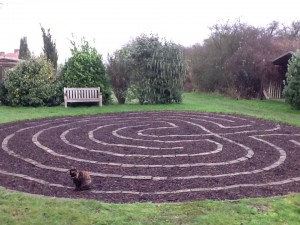 I’ve just arrived back from the village of Kingston in Canterbury having spent the better part of the morning and early afternoon in the delightful home of Lizzie and John Hopthrow.
I’ve just arrived back from the village of Kingston in Canterbury having spent the better part of the morning and early afternoon in the delightful home of Lizzie and John Hopthrow.
Lizzie has generously offered us the use of the land at their home at The Quiet View in the village of Kingston in Canterbury to run the first in our series of Writing with the Senses workshops this month on Saturday 26th January from 10am-4pm.
We hope you will join us on a day of writing where you’ll coax your writing back onto the page with a series of writing activities and exercises stimulated by the senses and nature.
Whatever your writing genre this workshop offer you time and space to write and generate writing that will inspire your writing and creativity in other areas.
You’ll also benefit from a 30-minute follow up coaching session with me along with the Writing with the Senses e-book.
My workshops are known for the intimacy that is quickly created in our groups, the creativity that is introduced with each activity and the depth that writers reach when writing in a true and authentic way. To put it mildly our workshops are always special which is why we’d love for you to join us. For more details check out the Resources page on our website.
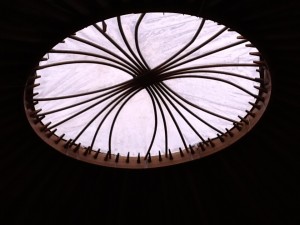
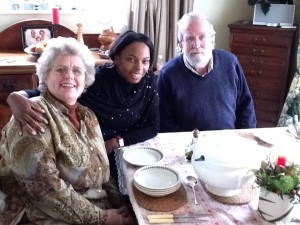 We’ll be housed in the delightful Yurt surrounded by sheep, horses, a great skyline and of course Dusty the cat who took her first walk on the Yurt roof today and wouldn’t come down.
We’ll be housed in the delightful Yurt surrounded by sheep, horses, a great skyline and of course Dusty the cat who took her first walk on the Yurt roof today and wouldn’t come down.
For those travelling from London there’s a fast train from London Victoria to Faversham and we can arrange pick-ups at a small charge.
In the meantime enjoy some of the photos from our visit today to prepare for the 26th.
For more details on Quiet View check out www.quietview.com
I look forward to seeing you.
Have a SUPER weekend and make sure you wrap up warm.
Jackee
No Comments
Saturday, January 5th, 2013
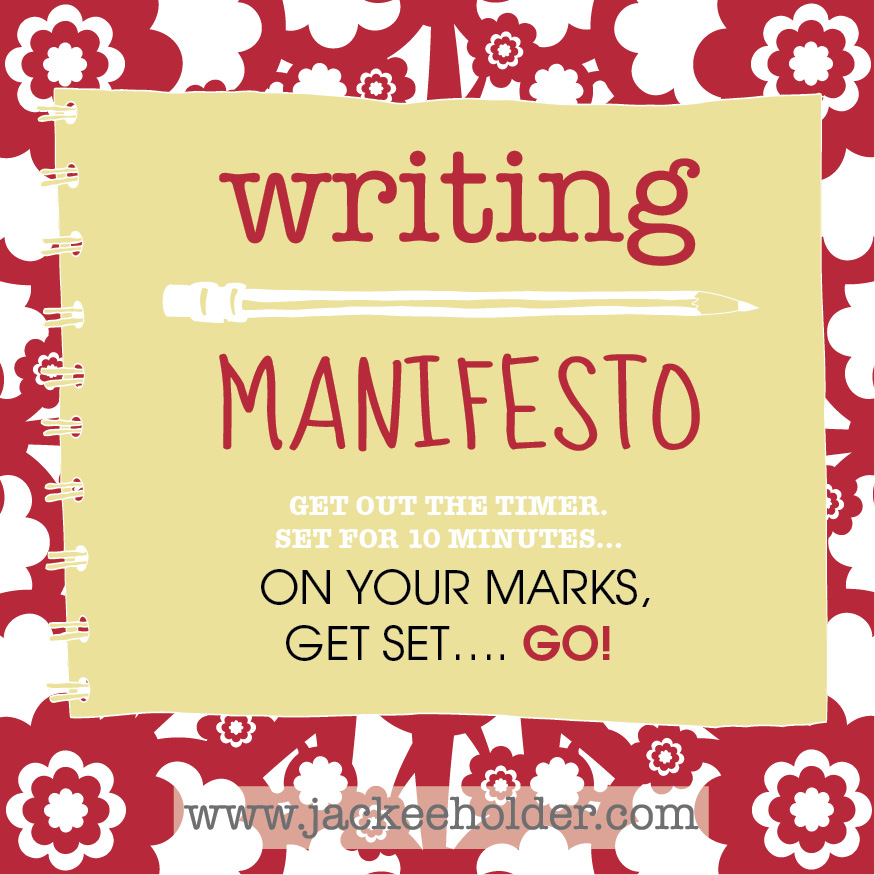
I’ve been a student of the writing process for over thirty years. In that time I’ve read hundreds of books and articles on the creative writing process, attended numerous writing and creativity workshops, facilitated writing workshops and retreats for writers and been coached by writers and authors around the world.
We’re living in a world where writing is one of the most powerful forms of communication and is not just left in the hands of the traditional writers and authors of past generations. Writing belongs to everybody and everybody is potentially a writer.
Whatever your business whether you’re working inside an organization or outside of an organization either as an artist or entrepreneur we all need to develop the skill of communicating through writing.
Every business, entrepreneur, artist, employees needs a platform and platforms are where we tell our stories whether through images or words in order to communicate the core and heart of our business.
There’s no leadership without engaging in writing. Therefore all leaders need to engage and embrace some form of a writing practice in 2013.
That’s why I created the Writing Manifesto for you. In one place I’ve distilled some of the nuggets I’ve learnt about the writing process as inspiration for embedding your own writing practice that will help catapult your platform in 2013.
These tips are universal and apply to you whether you write a blog, keep a journal, create business content for your website or contribute to a company newsletter.
Our Writing Manifesto contains 13 tips on the writing and creative process. You might choose to start off this month by working with just one or two of the tips and then move onto new tips over the coming months.
Wherever you begin I suggest that you have a notebook to capture ideas and thoughts. The world needs your creativity and ideas. No leader should be without some form of a notebook in 2013.
It’s available as a printable pdf or downloadable as wallpaper for your desktop.
Click here for the printable version
Click here for the wallpaper version
No Comments
Wednesday, December 26th, 2012
I hope you’ve had a wonderful Christmas day. I spent my day with eight members of my family and a family friend in Barbados where we’d all gathered to celebrate my Mum’s 80th birthday.
My Mum, Celestine is an amazing woman. She’s fit and well and still travels around on her own, and is fiercely independent. When the first of her tribe form the UK arrived last week unannounced we found her sitting in the middle of her living room with all the furniture piled into the middle of the room, which she had moved, all by herself. She was sipping a cup of tea, watching the day time TV drama, Days Of Our Lives (which half of the Barbadian population is addicted to). She’d engaged someone to paint the living room and was sitting back admiring the new coat of paint on the living room walls.
This year it was not the usual stuffing of food and drink on Christmas day for me. I’ve had a bout of mild food poisoning so I found myself eating and drinking very little. My day started off well. Got up at 4am to talk with my Mum, as she got ready for the annual Christmas day ritual on the island of attendance at church for a 5am service. All over the island Barbadians would descend upon the hundreds of churches in existence on the island for the traditional 5am Christmas service. With Mum’s departure I was left with three hours alone at home. Time alone is the best time for my creativity to manifest. I find myself falling into a space of deep refection and free-associating ideas in a process of cross fertilisation.
Creativity is a wonderful thing. I remember a quote I heard on a course years ago by the dancer Gilda Radner, ” I may get distracted by my need for love, but eventually I’ll get horny for my creativity. ” I feel that so much in my life in these later years. In my work as a coach and a writer creativity is what adds that spark, brings to life the richness of our encounters and experiences in everyday life. It’s what makes me feel alive, engaged and whole. Don’t get me wrong, love is important both love of others and the self but without creativity what use is love I ask myself. Many a time connecting with my creativity, doing something creative in an ordinary moment deepens my sense and feel of love. Can you imagine a life without creativity?
That’s why in the middle of Christmas day, which by the way here in Barbados rained for the better part of the day, when the sun came out I grabbed my iPad and walked down our street taking photo’s of the area with my sister. It lasted only for 10 minutes or less but we both had so much fun taking in the scenes and different objects, the contrasts of colours and textures, really seeing and looking at things around us. We got to about ten shots before the sun swiftly disappeared and the rain belted once down again drenching the area.


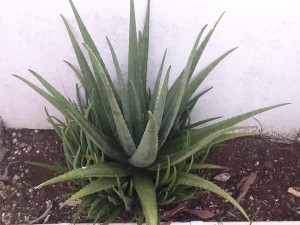


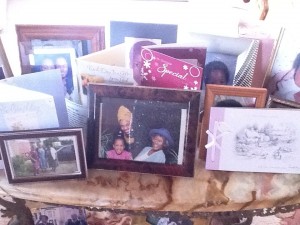
As part of the Christmas and New Year festivities we’re giving away three free gifts. Please grab your copy of the first of our Manifestos. This first one is all about Creativity. A list of gentle reminders about what you don’t and do need to get in touch with your creativity. Click here to download the Creativity Manifesto which you can download and print off.
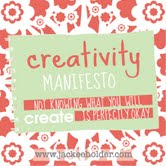
We hope you enjoy. Watch out for the two remaining Manifesto’s on Writing and Connecting with Nature coming early in the New Year. We’ll post them both on the blogs and on the website as well as making them available on Twitter and LinkedIn.
Enjoy Boxing day and your gift from us here at www.jackeeholder.com
No Comments
Friday, December 21st, 2012
 I’m in the Caribbean enjoying the benefits of so many books at my fingertips which means I can have unlimited access to on my Kindle. I no longer worry about the weight of my suitcase especially since Virgin Airlines have penalized us and placed restrictions for one suitcase only on Caribbean flights from London to the Caribbean. Not good news for a book, loving reader like me. One of the books I am enjoying on my Kindle is a new book I discovered by Jean Shinoda Bolen, Like A Tree.
I’m in the Caribbean enjoying the benefits of so many books at my fingertips which means I can have unlimited access to on my Kindle. I no longer worry about the weight of my suitcase especially since Virgin Airlines have penalized us and placed restrictions for one suitcase only on Caribbean flights from London to the Caribbean. Not good news for a book, loving reader like me. One of the books I am enjoying on my Kindle is a new book I discovered by Jean Shinoda Bolen, Like A Tree.
There’s always that dilemma about whether you should dip into reading a book on the same topic of a book you’re also writing about. Bolen’s book holds many similarities to the book I am writing about trees. It felt uncanny as I clicked through her pages noting many of the same references and books we both shared and at times doubting whether it was really worth me continuing with my own story at all.
This is a common challenge for writers. We lose heart when we find others writing around similar themes and topics. We imagine that our own stories must be a hundred percent original which of course is impossible. There is a saying that there are only seven stories any writer can write about and what we can do is write our own version of that story. That’s when I realized how important it is to distinguish the reasons why you should continue with writing your own version or story especially when you feel someone has just written the book you were meant to write.
My ten tips are based on my experience of reading Like A Tree are which is so close to the book I have been working on for several years Tree wRites:
1. My personal stories about trees are completely original and stand out as different from the personal stories Jean shares in her book.
2. It’s good news that a book been published on a topic that I’m also passionate about and dedicate to writing about
3. I’ve gained loads of new ideas for enhancing my own book, which included not trying to include too much, which I felt Jean was in danger of doing.
4. I’ve added new titles of books to read about trees to my collection, which always excites me.
5. I’ve gained new knowledge about trees and discovered new names of trees I’d never heard of before
6. I was able to distinguish how my book was different form Bolen’s book and gained greater clarity for communicating this in my book proposal.
7. I realized how important it was for me to share my tree stories and my love of trees even if the book does not end up being published by a mainstream publisher it will be a book I will be proud to publish myself.
8. It was further confirmation that there is a market for books like this and that my contribution is needed.
9. A timely reminder that no two books are ever the same.
10. Acknowledging how much I enjoyed reading Like A Tree and that some day other readers will feel the same from reading my version.
I don’t have the exact quote with me but I remember Barbara Kingsolver saying something like it took nearly 50 years for the story of the Poison Wood Bible to be ready to be written. I recognize that it has been over 15 years that this book about trees has been with me. It has been a process of incubation, maturing and finding its voice. Over the years more personal stories have come and found me. I’ve gained more knowledge about trees and synthesized much of what I am writing about. The book has taken me to it right form over time, which has felt right. I value the creative process in shaping this book and know deep inside me that not all books will be written fast and furious and that for many it will take years for the book to find it’s voice, it’s heart and it’s form.
There are many metaphors from the world of trees I can apply to my writing of this book. I have learnt patience. That it takes years for many trees to grow and it has been the same with this book, For some years it laid idle, only to go through a growth spurt and to be revived again. It has been sent out and rejected over twenty times but returned, shedding words and pages, even themes and stories and budding new leaves and blossoms as it entered a new spring. In many ways my book about trees is planting roots and when it is ready it words will branch out and write what needs to be written and I will intuitively know when the book is ready.
Just like a Tree is available from www.amazon.co.uk
No Comments
